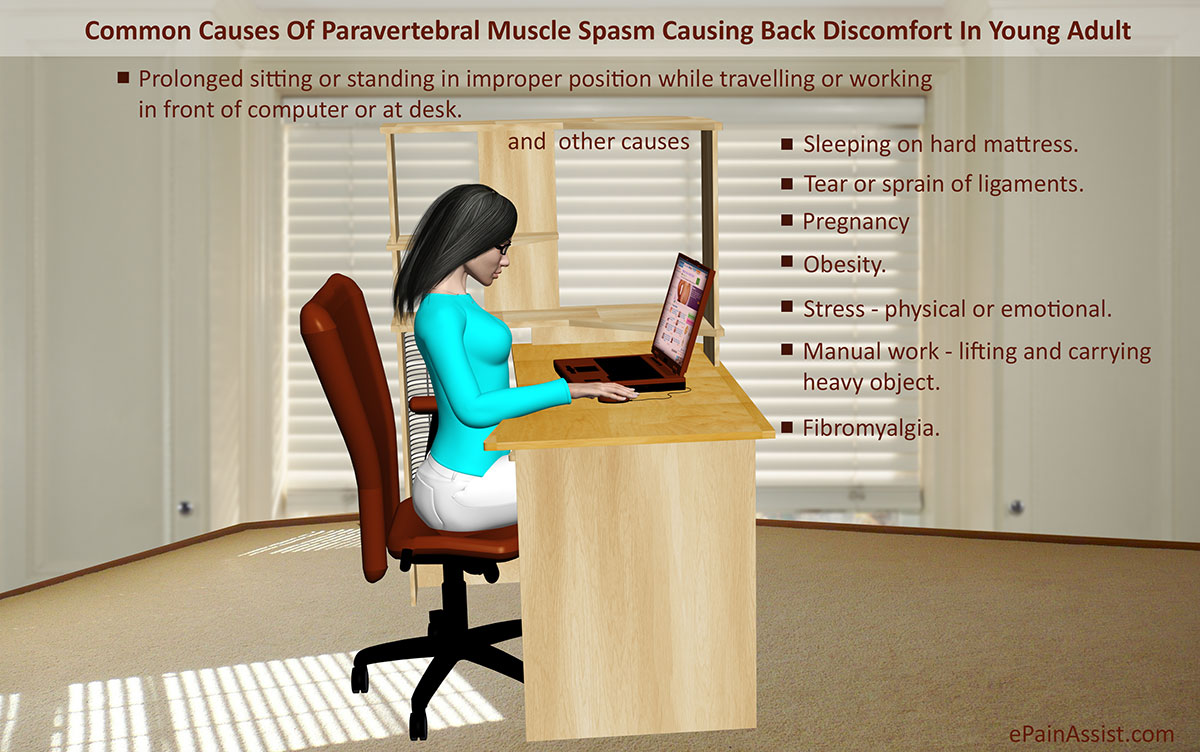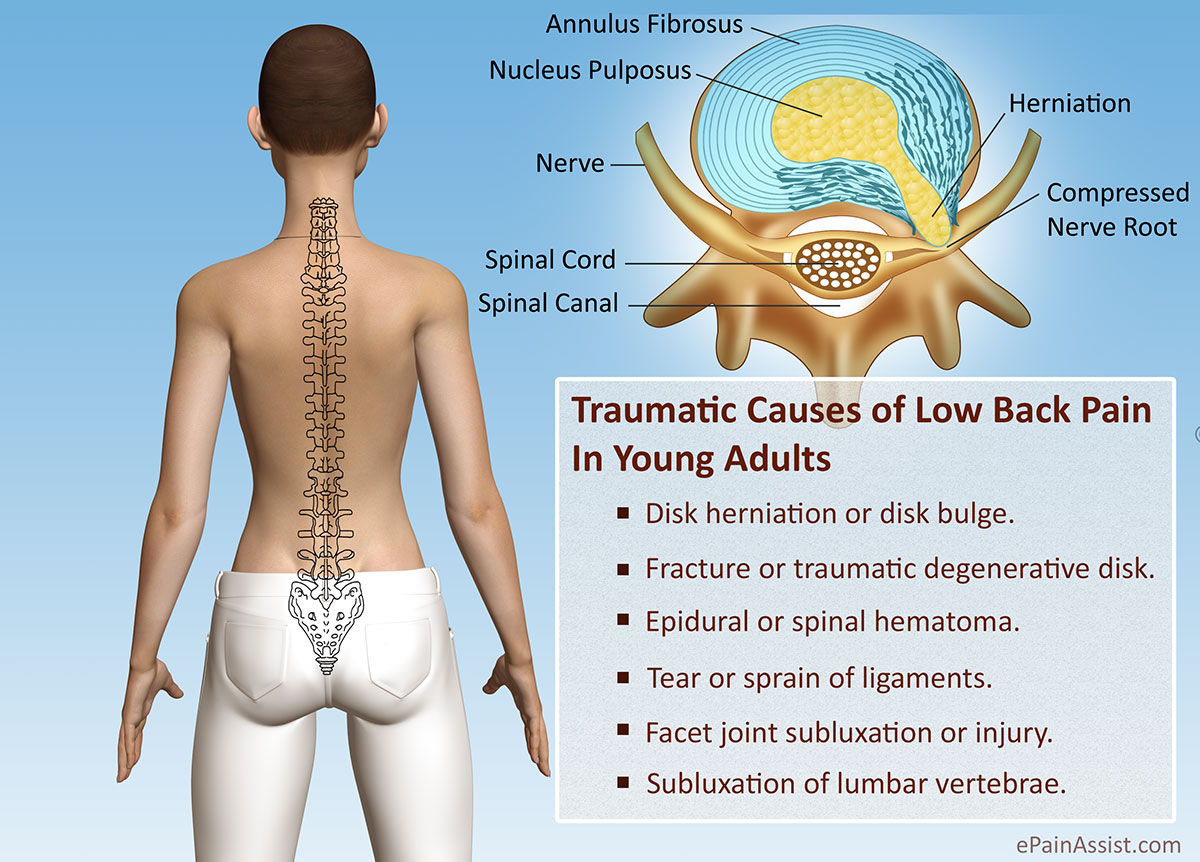I Am Just 25-Year-Old, Why My Back Hurts?
Young adult suffering with chronic back pain is rare. Back pain less than 3 month is recognized as acute back pain and if it is longer than 3 months it is called chronic back pain.1
Back pain following fall, auto accident or work accident can be serious and needs further investigations as soon as possible. Backache in patient who is just 25 year old with no history of trauma is mostly secondary to muscle spasm. Vertebral column is an essential segment of skeletal system for weight transmission. Lumbar segment of vertebral column carries 2/3rd or less of a body weight to extremities. Paravertebral muscles support lumbar vertebral segment. There are several bilateral paravertebral muscles. Muscle spasm is the most common cause of backache in young adult male or female.2

What Are The Common Causes Of Paravertebral Muscle Spasm Causing Back Pain or Back Discomfort In Young Adult?
Paravertebral muscle spasm in young adult is caused by following conditions
- Undiagnosed scoliosis.
- Prolonged sitting or standing in improper position while traveling or working in front of computer or at desk.
- Sleeping on hard mattress.
- Tear or sprain of ligaments.
- Tear or sprain of paravertebral muscles.
- Pregnancy.
- Obesity.
- Stress – physical or emotional.
- Manual work – lifting and carrying heavy object.
- Sciatica.
- Myofascial muscle disease.
- Fibromyalgia.
What Are The Non-Traumatic Causes Of Back Pain or Back Discomfort In Young Adult, Which May Need Further Investigation?
- Disk bulge or herniation.3
- Paravertebral or spinal abscess.
- Spinal tumor or osteoblastoma.
- Epidural or spinal hematoma.
- Facet joint arthropathy.
Skeletal or soft tissue damage caused by trauma secondary to auto accident, work accident or fall are as follows :
- Disk herniation or disk bulge.
- Fracture or traumatic degenerative disk.
- Epidural or spinal hematoma.
- Posttraumatic epidural or spinal abscess.
- Tear or sprain of ligaments.
- Tear or sprain of paravertebral muscles.
- Facet joint subluxation or injury.
- Subluxation of lumbar vertebrae.
When Should I Consider Further Investigation For Back Pain in Young Adult?
Mild to moderate pain, not responding to non opioid pain medications such as NSAIDs, if continues after 3 months then pain is considered as chronic pain, which needs further investigations.
Majority of the back pain, about 98% or so, is nonspecific and self-limiting. Image study has revealed that up to 85% of people with low back pain, despite a thorough medical examination have not shown any specific cause of the pain. Symptoms may disappear within 2 to 4 weeks in 98% of the patients complaining of low back pain. Only 2% of patients continue having symptoms beyond 4 weeks and are supported by specific diagnosis. Pain or discomfort in the back is the second most common symptom after headache requiring frequent emergency room visit. Disc herniation has been observed in 33% of the adults older than 30 years, but only 2% suffer with long-term chronic pain. In USA, 90% of Americans at some point in their lifetime suffer with low back pain and are unable to work for few days. After the initial episode of backache, 50% will have more than one incident. Radicular pain or sciatica may be associated with low back pain and 80% of patients will eventually recover with or without surgery.
Which Investigations Are Most Favorable To Identify The Cause of Back Pain in Young Adult?
Most favorable initial investigation is X-Ray and MRI or CAT scan.
Which Other Investigations May Need To Be Considered?
- Blood examinations to rule out infection and abscess.
- EMG (Electromyogram) studies to diagnose muscle diseases.
What Are The Treatment Options For Back Pain In Young Adult Aged 25 Years ?
Treatment choices are several non-invasive and invasive treatment. Benign backache may not need any of the following treatment except NSAIDs and rest. But choice is as follows:
Non-Invasive Treatment Options For Young Adult Having Back Pain
- Non-opioid medications such as NSAIDs (Tylenol, Motrin, Naproxen and Celebrex), antidepressant analgesics (Elavil and Cymbalta) and antiepileptic analgesics (Neurontin and Lyrica).
- Manual treatments, which may be helpful, are as follows :
- Massage treatment 4
- Spa Therapy
- Yoga Exercises for Back
- Chiropractic Manipulations
- Physical Therapy
Invasive Treatments Options For Young Adult Having Back Pain
Interventional Pain Therapy:
- Epidural Steroid Injection.
- Facet Joint Injection.
- Selective Nerve Root Injection.
- Trigger point injection.
Surgical Treatment Options For Back Pain in Young Adult Aged 25 Years Old
Surgical Treatment Depends On Cause Of The Pain Leading To Back Discomfort. Surgical treatment may be necessary which includes
- Discectomy.
- Spinal Fusion.
- Removal of abscess or hematoma.
- Excision of tumor mass.
- Spinal Cord Stimulator.
- Intrathecal catheter and pump to deliver intrathecal pain medications.


